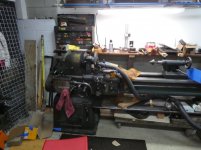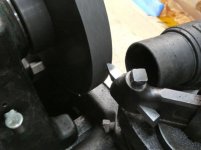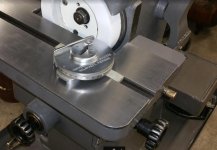I just got through my fist work session with the big girl and it's pretty enjoyable to operate the big 16". I am working on that backplate for the three jaw chuck so it's a cast iron part and after the folks here sorted me out I was making chips...er...a...sort of a heavy sand! Seems like it is a little too easy to push the lathe to a point where the belt slips off and then no power. Maybe a blessing in disguise since I am pretty green?
About the best depth per cut I could manage was .01 at 80 RPM spindle speed. Anymore and the belt would slip off the position. I was using the auto feed too at about .012 per revolution. That was all good for about an hour, then I decided to stop and post and see what wisdom or encouragement might be shared... plus I needed a rest.
I made my first HSS 3/8" cutter too in the form of a right hand cutting tool. Pretty long process since my grinding wheels are pretty fouled up and I couldn't find the dressing tool. Is there an old school way to dress them? It probably took me an hour to make that one tool!
I am pleased with how it performed for the first 12-15 1 inch passes or so but then the work piece started to look gummed up and not clean grooves like I started out with. How long should I expect the cutter to remain optimal in cast? I took a few pictures as I was getting close to being done.
I rigged up a shop vac to try and collect as much stuff as I could.

I tried to get some picures of the chips flying but it didnt work.

Here's the general setup. Working this close to the headstock there isnt a lot of room.IO had to slide lantern off center to get the room.

Here's how the passes were starting to look at the end. I will sharpen the tool before I begin again. I am sure the tool wasn't perfect but I was really pleased with the geometry.

more picture in next post...
About the best depth per cut I could manage was .01 at 80 RPM spindle speed. Anymore and the belt would slip off the position. I was using the auto feed too at about .012 per revolution. That was all good for about an hour, then I decided to stop and post and see what wisdom or encouragement might be shared... plus I needed a rest.
I made my first HSS 3/8" cutter too in the form of a right hand cutting tool. Pretty long process since my grinding wheels are pretty fouled up and I couldn't find the dressing tool. Is there an old school way to dress them? It probably took me an hour to make that one tool!
I am pleased with how it performed for the first 12-15 1 inch passes or so but then the work piece started to look gummed up and not clean grooves like I started out with. How long should I expect the cutter to remain optimal in cast? I took a few pictures as I was getting close to being done.
I rigged up a shop vac to try and collect as much stuff as I could.

I tried to get some picures of the chips flying but it didnt work.

Here's the general setup. Working this close to the headstock there isnt a lot of room.IO had to slide lantern off center to get the room.

Here's how the passes were starting to look at the end. I will sharpen the tool before I begin again. I am sure the tool wasn't perfect but I was really pleased with the geometry.

more picture in next post...





 ...I have smaller chuck backs for sale.
...I have smaller chuck backs for sale.








